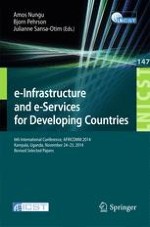2015 | Buch
e-Infrastructure and e-Services for Developing Countries
6th International Conference, AFRICOMM 2014, Kampala, Uganda, November 24-25, 2014, Revised Selected Papers
herausgegeben von: Amos Nungu, Bjorn Pehrson, Julianne Sansa-Otim
Verlag: Springer International Publishing
Buchreihe : Lecture Notes of the Institute for Computer Sciences, Social Informatics and Telecommunications Engineering
